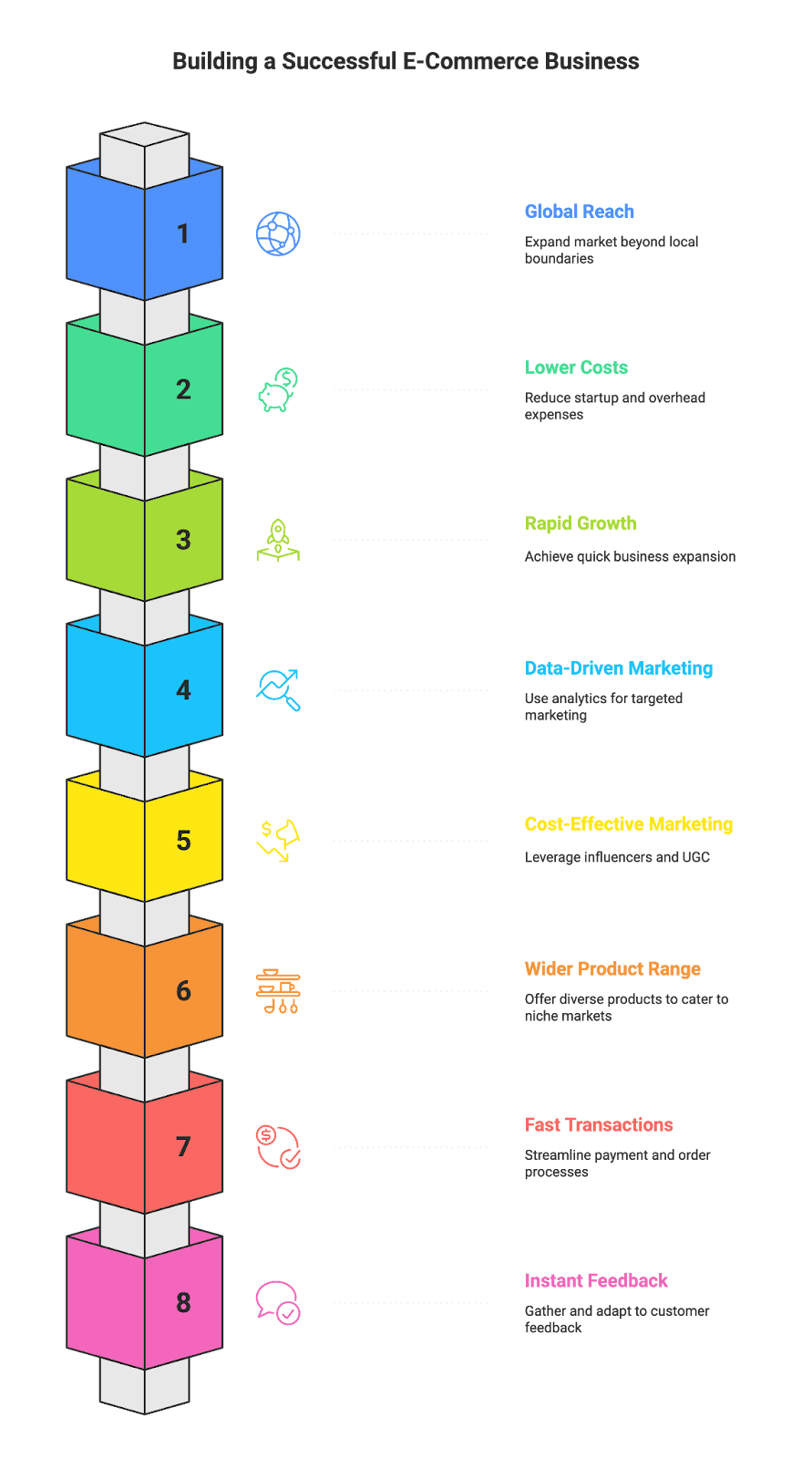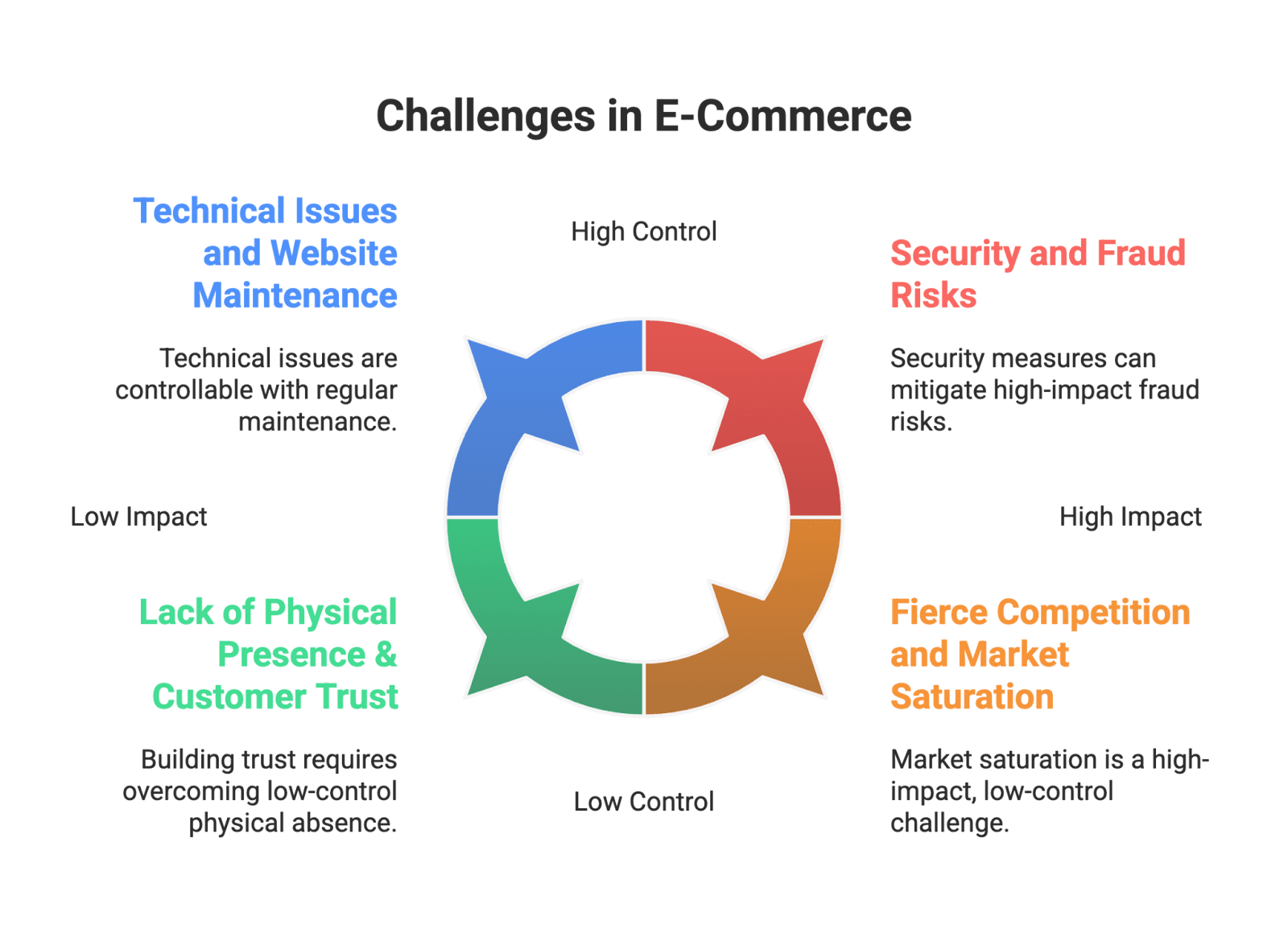Ecommerce Advantages and Disadvantages
24th
July, 2025
Influencer Marketing
Amazon Marketplace
Artificial Intelligence
TikTok Tips
Starting an e-commerce business is an exciting journey for new B2C entrepreneurs. You’ve probably seen the success of Amazon sellers and the buzz created by micro influencers on social media. E-commerce enables anyone to reach customers globally from day one, and even tap into content creators to build brand awareness. Let’s dive into the ecommerce advantages and disadvantages that can make or break your B2C venture.
Advantages of E-Commerce

E-commerce has transformed how we do business, and it comes with some compelling advantages for entrepreneurs. Here are some of the biggest advantages of e-commerce for B2C startups:
1. Global Market Reach (Sell 24/7)
An online store isn’t tied to a single location or business hours. You can reach customers across different cities, countries, and time zones – effectively selling 24/7 without ever opening a physical storefront. This around-the-clock availability means you could be making sales while you sleep. Even a small business can attract a worldwide customer base online, something traditional retail could never do as easily.
2. Lower Startup Costs and Overhead
Launching a basic e-commerce website is often much cheaper than opening a brick-and-mortar shop. There’s no rent for a physical store, fewer staff members needed, and minimal upfront investment beyond inventory and a website. Many e-commerce platforms and tools today are affordable or even free to start. You can be an Amazon seller with just a small listing fee or run a Shopify store on a shoestring budget. This lower barrier to entry lets entrepreneurs test ideas online with far less risk and cost than a traditional retail business.
3. Rapid Growth and Scalability
E-commerce is one of the fastest-growing segments in retail, which is a huge plus for new businesses. The online market is massive and still expanding each year. Global e-commerce retail sales have soared from about $1.5 trillion in 2015 to over $6 trillion in 2024, and they’re projected to keep rising. You’re essentially entering a growing market with momentum behind it. Need to scale up? In e-commerce, that might be as simple as upgrading your web hosting and adding more stock – no need to build new stores. This flexibility means your business can grow quickly without the usual growing pains of physical expansion.

Unlock the Power of Micro Influencers and Elevate your Brand Today!

4. Data-Driven Marketing and Personalization
Online selling gives you access to a goldmine of customer data and analytics. You can track every click, view, and purchase to understand what your customers want. This data helps you optimize your marketing and website experience on the fly. For example, you can see which products are popular, where customers drop off in the checkout process, or which ads convert best. With e-commerce, even small businesses can leverage personalized marketing techniques – like recommending products based on browsing history or sending targeted email offers – that would be impossible in a generic physical store. The result is more effective marketing and higher conversion rates, because you’re tailoring the shopping experience to each customer’s interests.
5. Cost-Effective Marketing with Micro Influencers and UGC
Traditional advertising can be expensive and less effective nowadays, especially for a new B2C brand. E-commerce opens up modern, cost-effective marketing channels. You can collaborate with micro influencers on Instagram, TikTok, or YouTube who promote your products to their engaged niche followers. In fact, micro-influencers often generate 60% more engagement than larger influencers, making their recommendations feel like genuine word-of-mouth endorsements. Likewise, encouraging customers to share reviews, unboxing videos, and other user-generated content (UGC) can significantly boost your brand’s credibility. Shoppers trust real customer experiences – 84% of people are more likely to trust a brand that uses UGC, and 77% say UGC influences their buying decisions. For you, this means free or low-cost content that serves as powerful social proof. Between influencer partnerships and UGC, an online business can build trust and buzz without the mega-budget that traditional marketing might require.
6. Wider Product Range & Niche Opportunities
Without the physical constraints of a storefront, e-commerce lets you offer a much wider range of products. You can list dozens or even thousands of items in your online catalog, far beyond what a small shop could display. This means you can cater to niche markets and varied customer preferences. Whether you’re selling custom phone cases or eco-friendly pet supplies, you’ll find customers from all over who are interested. Being online also means you can pivot or expand your product line quickly by reacting to market trends or customer feedback. In a physical store, adding new products might mean finding shelf space or opening new locations; online, it could be as simple as adding a new category on your website.
7. Fast and Flexible Transaction
E-commerce streamlines the entire buying process for both the seller and the customer. Payments are handled instantly through secure payment gateways, and funds can flow to your account faster than waiting for a monthly check from a distributor. You can offer multiple payment options (credit cards, PayPal, digital wallets, “buy now pay later” services, etc.) with a few clicks, which makes it easy for customers to complete purchases – and more completed purchases means more revenue. Automation is another big plus: orders can trigger automatic invoices, update your inventory, and send confirmation emails without you lifting a finger. This level of efficiency frees up your time to focus on growth, rather than manual paperwork.
8. Instant Customer Feedback and Adaptation
In the e-commerce world, feedback is often immediate. Customers can leave product reviews, post on social media, or respond to email surveys quickly. This direct feedback loop is incredibly valuable for improving your business. If a product has a common issue, you’ll know about it and can fix it or address it in your listings. If customers keep asking for a new feature or product variation, you can adapt to meet that demand. By paying attention to reviews and social media comments (a form of UGC as well), online businesses can continuously refine their offerings and customer service. Ultimately, this leads to better customer satisfaction and loyalty – an advantage that grows your reputation over time. Many small businesses benefit from using the Aircall customer communication platform to streamline customer communications, collect valuable feedback, and provide fast, personalized support. Tools like this simplify managing inquiries and help boost customer satisfaction while allowing businesses to scale efficiently
In short, the advantages of e-commerce can empower small business owners to compete with larger players by leveraging technology, data, and creative digital marketing. A one-person online shop can potentially reach millions of consumers, use sophisticated marketing tools, and operate at low cost – something unimaginable in the old brick-and-mortar model. It’s this democratization of retail that makes e-commerce so appealing.
If you’re a new B2C entrepreneur excited by these advantages, now is the perfect time to take action. Brainstorm that product idea, set up your online store, or create your first Amazon seller account – don’t be afraid to start small and learn. Leverage the tools at your disposal (for example, consider reaching out to micro influencers or using Stack Influence’s platform to get the word out) and start building your e-commerce presence today. Every big e-commerce success story starts with that first step!

Unlock the Power of Micro Influencers and Elevate your Brand Today!

Disadvantages of E-Commerce

While e-commerce offers plenty of benefits, it also comes with its own set of challenges and drawbacks. It’s important to go in with eyes open so you can plan to mitigate these issues. Here are the major disadvantages of e-commerce that new business owners should understand:
Fierce Competition and Market Saturation
One of the double-edged swords of e-commerce is the low barrier to entry – it’s easy for anyone to start an online store, which means everyone is doing it. Whatever your niche, there are likely hundreds of other online stores selling similar products. Big marketplaces like Amazon are incredibly crowded; Amazon itself has about 1.9 million active sellers on its marketplace (with roughly 548 new sellers joining every day). That means as a new entrant, you’re competing not just with other small businesses, but also with well-established players and Amazon’s own sold products. Standing out requires a clear unique selling proposition (USP), great branding, and savvy marketing. It can take significant effort (and advertising spend) to drive traffic to your site when you’re starting from zero in a saturated online market.
Another aspect of competition is the race to the bottom on pricing. Consumers can compare prices in seconds online. If your product is available from multiple sources, customers will often go for the best deal or the seller with the most trust (e.g., a high rating on Amazon). Small businesses can feel pressure to discount heavily or pay for ads to get visibility, which can cut into margins. To overcome this disadvantage, focus on differentiators other than price – like superior quality, exclusive products, or outstanding customer service – so that customers have a reason to choose you over the competition.
Lack of Physical Presence & Customer Trust
In a physical store, customers can touch, feel, or try products and talk to sales staff. In e-commerce, customers rely on photos, descriptions, and reviews. This lack of tangible interaction can make some shoppers hesitant to buy, especially for products where fit, quality, or style are important (think clothing, furniture, or anything you’d want to examine in person). A consequence is higher return rates for online purchases – people might order multiple sizes or variants expecting to send some back, or they may be disappointed if a product doesn’t meet expectations in real life.
Trust is another related issue. A new online store with no track record might raise red flags for consumers: Is this site legit? Will the product look like the photos? Is my payment information safe? Building trust online takes time and effort. Until you have a solid base of customer reviews and a known brand, convincing first-time visitors to hit “Buy Now” can be challenging. It’s crucial to include clear information about your products, display reviews and testimonials (UGC can help here), and have transparent policies (for shipping, returns, privacy, etc.). Over time, as you gather happy customers and positive ratings, this disadvantage diminishes – but in the beginning, that lack of face-to-face reassurance is a hurdle.
Tip: To boost trust, focus on social proof and transparency. Encourage satisfied buyers to leave reviews and share their experiences. Highlight UGC like customer photos or unboxing videos. Implement live chat or chatbots to answer questions in real-time, mimicking the helpful interaction of an in-store clerk. Offer a generous return policy to reduce the risk for skeptical buyers. These steps can help bridge the trust gap that online shopping inherently has.
Technical Issues and Website Maintenance
Your e-commerce store is open 24/7 – but only if your website is up and running smoothly. Technical issues are a formidable disadvantage in online business. Website outages or slow load times can immediately cost you sales (if the site’s down, you’re essentially “closed” until it’s fixed). Even a few minutes of downtime during a big promotion can mean lost revenue. For instance, if you run an ad campaign and your site crashes from the traffic, potential customers will bounce and may not come back. Additionally, any complexities in the checkout process (broken buttons, payment gateway errors, etc.) can frustrate users and lead to abandoned carts.
Keeping a website running well requires ongoing maintenance. That means you’ll either need some technical know-how yourself or have to hire help. You’ll need to update software (e.g., plugin updates for your e-commerce platform), monitor for broken links or issues, and optimize for speed and mobile compatibility. There are also costs for web hosting, domain renewal, and possibly tech support or developers for custom features. While these costs are usually lower than physical store rent, they are continuous – you can’t just “set and forget” your website. Ensuring a reliable, fast, user-friendly site is an ongoing responsibility for e-commerce entrepreneurs.
Tip: Choose a reputable e-commerce platform or hosting provider known for reliability. It’s worth investing in good hosting so your site can handle spikes in traffic. Regularly test your site’s performance (many tools can monitor uptime and load speed). Also, have a plan for backups and a developer or support person on call in case something breaks. A smoothly running website is the lifeblood of your online business – prioritize it accordingly.
Security and Fraud Risks
Handling transactions online means dealing with sensitive customer data: credit card numbers, personal contact info, and so on. With that comes serious responsibility – and risk. E-commerce sites can be targets for cyberattacks, including hacking, data breaches, or credit card fraud. A single security breach can be devastating: not only could it cost you money (through chargebacks or theft), but it can also destroy the trust you’ve built with customers. Small businesses are sometimes seen as easier targets if they don’t have robust security measures in place.
Common security tasks for an online store include obtaining an SSL certificate (so your site is HTTPS secure), using secure payment processors (you typically shouldn’t handle raw credit card data yourself), and keeping your software/platform updated to patch vulnerabilities. You also need to be on the lookout for fraudulent orders – e.g., stolen credit cards being used to buy goods from you. If you ship a product only to later find out the payment was fraudulent, you often have to refund the charge, losing revenue and product. It’s a sad reality that e-commerce fraud exists and can hit new sellers hard if they’re not careful.
All of this means that e-commerce security is a necessary area to invest time (and some money) into. Services like fraud detection tools, secure checkout providers, and backups for your data are part of doing business online. It’s not the most glamorous part of e-commerce, but it’s extremely important.
Conclusion: Weighing the Pros and Cons
E-commerce offers a world of opportunity for new B2C business owners – you can launch quickly, reach a global audience, and leverage creative digital strategies like micro-influencer marketing and UGC to grow your brand. The advantages of e-commerce, from low startup costs to data-driven insights, make it an enticing path for entrepreneurs looking to break into retail or expand an existing business online.
So, is e-commerce right for you? That depends on your product, your target customers, and your willingness to adapt and learn. If you value flexibility, creative marketing, and the ability to scale fast, e-commerce is a fantastic avenue. Just be ready to wear many hats or partner with experts in areas where you’re less confident.
In the end, many entrepreneurs find that the benefits outweigh the drawbacks, especially as you gain experience and momentum. The barriers that seemed challenging at first – like learning SEO or managing inventory – become just another part of the business you’ve mastered. And the reward is a thriving online brand that can reach customers worldwide and potentially grow beyond what any local shop could achieve.
If you’re leaning toward starting your own e-commerce venture, now is the time to go for it. Do your research, build a solid plan addressing both the advantages and disadvantages we discussed, and take that first step. Launch your website, list your products, or open that Amazon store. Maybe even run a small social media campaign or send samples to a few micro influencers to get the ball rolling. Take action today – the sooner you start, the sooner you’ll be learning and optimizing. Remember, every major e-commerce success – from the local Etsy seller to the next big D2C brand – began with a first sale. You’ve got the knowledge; now put it to use and create your own e-commerce success story!
Good luck on your e-commerce journey, and feel free to bookmark this guide as a reminder of what to watch for. With preparation, passion, and persistence, you can ride the e-commerce wave and make your entrepreneurial dreams a reality. Happy selling!

By William Gasner
CMO at Stack Influence
William Gasner is the CMO of Stack Influence, he's a 6X founder, a 7-Figure eCommerce seller, and has been featured in leading publications like Forbes, Business Insider, and Wired for his thoughts on the influencer marketing and eCommerce industries.
Want new articles before they get published? Subscribe to our Awesome Newsletter.
stack up your influence
turning creativity into currency
our headquarters
111 NE 1st St, Miami, FL 33132
our contact info
[email protected]
stack up your influence
turning creativity into currency
our headquarters
111 NE 1st St, 8th Floor
Miami, FL 33132


